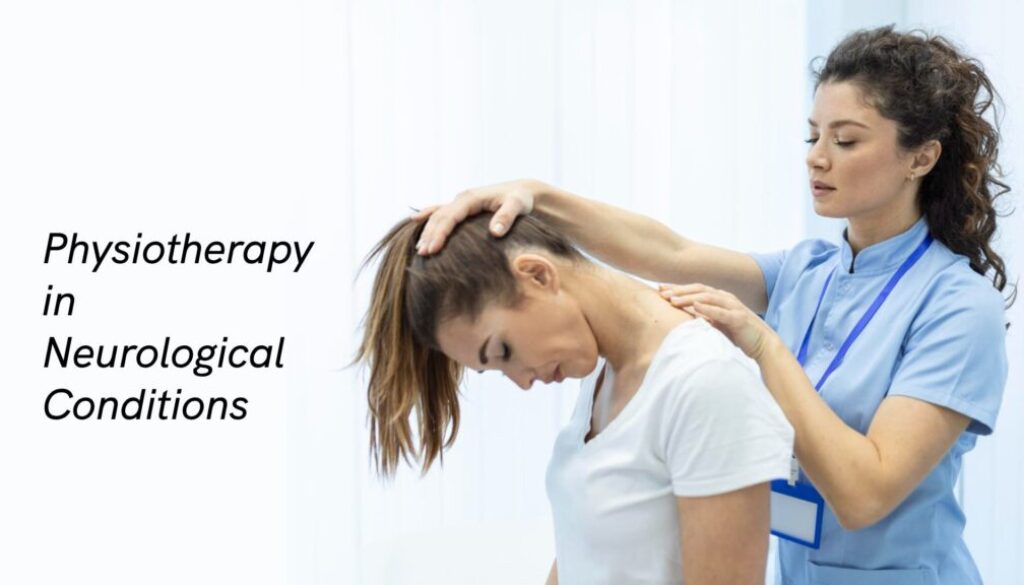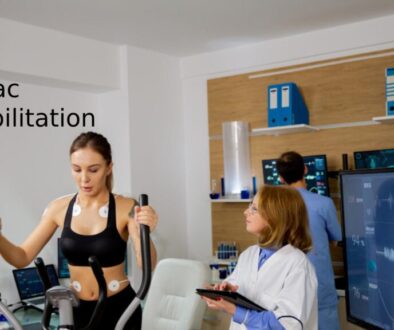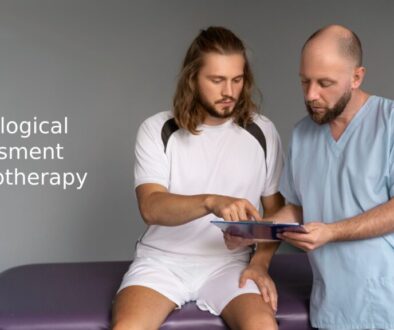Physiotherapy in Neurological Conditions & Recovery
Introduction
Physiotherapy plays a crucial role in managing and rehabilitating patients with neurological conditions. These conditions often affect movement, coordination, balance, and muscle control, making daily activities challenging. Physiotherapists use specialized techniques to restore mobility, improve strength, and enhance overall function in individuals with neurological disorders.
The primary goal of physiotherapy in neurological conditions is to help patients regain independence and enhance their quality of life. Since the nervous system controls muscle movement, damage to the brain or spinal cord can lead to significant motor dysfunction. Physiotherapy interventions focus on neuroplasticity—the brain’s ability to reorganize itself—to maximize recovery.
This article explores the role of physiotherapy in various neurological conditions, common rehabilitation techniques, and the impact of innovative therapies in enhancing patient outcomes.
Understanding Neurological Conditions
Neurological conditions refer to disorders affecting the brain, spinal cord, and peripheral nerves. These disorders can result from trauma, degenerative diseases, infections, or genetic factors. Some common neurological conditions that require physiotherapy include:
- Stroke – Can cause paralysis, muscle weakness, and impaired coordination.
- Parkinson’s Disease – Leads to tremors, rigidity, and difficulty with movement.
- Multiple Sclerosis (MS) – Affects the central nervous system, leading to weakness, fatigue, and balance issues.
- Spinal Cord Injury (SCI) – Can result in partial or complete loss of function below the injury level.
- Cerebral Palsy – A neurological disorder that affects movement and posture from childhood.
Neurological disorders often lead to decreased mobility, balance impairments, muscle weakness, and coordination problems. Physiotherapy is essential to counteract these effects and promote better functional outcomes.
Role of Physiotherapy in Neurological Rehabilitation
Physiotherapy plays an essential role in neurological rehabilitation by:
- Enhancing neuroplasticity – Helping the brain form new connections to compensate for lost functions.
- Preventing secondary complications – Such as muscle stiffness, contractures, and pressure sores.
- Improving mobility and independence – Through strength training, coordination exercises, and balance training.
- Boosting confidence and mental well-being – Encouraging patients to regain control over their movements.
Early intervention is crucial in neurological rehabilitation. The sooner a patient starts physiotherapy, the better the chances of recovery and adaptation.
Common Physiotherapy Techniques in Neurological Rehabilitation
Physiotherapists use a variety of techniques tailored to individual patient needs. Some of the most effective methods include:
Neuroplasticity-Based Rehabilitation
- Encourages the brain to reorganize and form new pathways for movement.
- Exercises involve repetition and task-specific training.
Passive and Active Exercises
- Passive exercises involve assisted movements to prevent muscle stiffness.
- Active exercises encourage the patient to move independently and regain control.
Manual Therapy and Hands-On Techniques
- Massage and stretching to reduce spasticity and pain.
- Joint mobilization to improve flexibility and range of motion.
These physiotherapy techniques form the foundation of neurological rehabilitation and are adapted based on the patient’s progress.
Specific Neurological Conditions and Physiotherapy Approaches
Stroke Rehabilitation
- Focuses on regaining lost movement and preventing contractures.
- Includes gait training, strength exercises, and balance training.
Parkinson’s Disease
- Emphasizes coordination exercises and postural correction.
- Includes rhythmic movements and gait re-education.
Multiple Sclerosis (MS)
- Addresses fatigue, balance issues, and muscle weakness.
- Involves endurance training and aquatic therapy.
Spinal Cord Injury (SCI)
- Aims to improve function based on injury level.
- Includes functional electrical stimulation and mobility aids.
Cerebral Palsy
- Early intervention helps improve motor function in children.
- Focuses on flexibility, strength, and coordination training.
Physiotherapy is tailored to each condition to maximize independence and quality of life.
Advanced Physiotherapy Techniques for Neurological Rehabilitation
Advancements in physiotherapy have led to specialized techniques that enhance neurological rehabilitation. These methods focus on stimulating the nervous system, improving movement, and promoting neuroplasticity.
Bobath Concept (Neurodevelopmental Treatment)
- Focuses on postural control and movement facilitation.
- Helps patients regain coordinated movement through guided activities.
- Used widely for stroke, cerebral palsy, and brain injury rehabilitation.
Constraint-Induced Movement Therapy (CIMT)
- Encourages the use of affected limbs by restricting the unaffected side.
- Effective in stroke recovery for restoring hand and arm functions.
- Helps retrain the brain to improve motor skills.
Functional Electrical Stimulation (FES)
- Uses electrical impulses to stimulate weak or paralyzed muscles.
- Enhances muscle strength and prevents atrophy.
- Beneficial for spinal cord injuries, stroke, and multiple sclerosis.
Vestibular Rehabilitation for Balance Disorders
- Helps patients with dizziness and balance issues.
- Uses head movement exercises and gaze stabilization techniques.
- Beneficial for conditions like Parkinson’s disease and traumatic brain injury.
These advanced physiotherapy techniques improve recovery outcomes and enhance patient mobility.
The Role of Assistive Devices and Technologies
Neurological physiotherapy often incorporates assistive devices and cutting-edge technologies to aid rehabilitation. These tools support mobility, enhance muscle function, and improve independence.
Use of Walking Aids and Braces
- Canes, walkers, and orthotic braces support walking stability.
- Reduces fall risk and promotes safe movement.
Robotic-Assisted Rehabilitation
- Robotic exoskeletons help patients regain movement.
- Used in spinal cord injury and stroke recovery.
Virtual Reality (VR) and AI-Driven Therapy
- Engages patients in interactive exercises for motor training.
- Improves motivation and provides real-time feedback.
These technological advancements revolutionize neurological rehabilitation, making therapy more effective and accessible.
Importance of Gait Training in Neurological Rehabilitation
Gait training is crucial for patients recovering from neurological conditions. It helps improve walking ability, posture, and movement coordination.
Techniques to Improve Walking Patterns
- Step training and weight-shifting exercises.
- Strengthening exercises for leg muscles.
Use of Treadmill and Weight-Supported Gait Training
- Reduces weight-bearing load while practicing walking.
- Helps patients with spinal cord injuries and stroke regain mobility.
Proprioception and Sensory Re-Education
- Improves balance and body awareness.
- Essential for conditions affecting sensory nerves.
Proper gait training enhances mobility, allowing patients to regain confidence in walking.
Strength and Endurance Training in Neurological Patients
Neurological disorders often lead to muscle weakness and reduced stamina. Physiotherapists incorporate strength and endurance training to improve overall function.
Importance of Muscle Strengthening
- Prevents muscle atrophy and maintains joint stability.
- Includes resistance training, weightlifting, and bodyweight exercises.
Cardiovascular Fitness for Neurological Patients
- Enhances heart and lung function, reducing fatigue.
- Involves cycling, swimming, and aerobic exercises.
Role of Resistance and Aerobic Exercises
- Resistance training builds muscle strength.
- Aerobic exercises improve blood flow and endurance.
Strength training helps patients become more independent and reduces the risk of falls.
Managing Pain and Spasticity in Neurological Conditions
Pain and muscle stiffness are common in neurological conditions. Physiotherapy includes various strategies to relieve discomfort and improve movement.
Physiotherapy Techniques for Pain Relief
- Manual therapy, stretching, and massage to reduce muscle tension.
- Ultrasound and electrical stimulation for deep tissue pain relief.
Strategies to Reduce Muscle Stiffness and Spasticity
- Stretching exercises and range-of-motion movements.
- Botulinum toxin (Botox) injections combined with physiotherapy.
Hydrotherapy and Heat Therapy
- Warm water exercises reduce spasticity and improve circulation.
- Heat packs and paraffin wax therapy help relax tight muscles.
Effective pain management techniques improve patient comfort and participation in therapy.
Psychological and Emotional Support in Neurological Rehabilitation
Neurological disorders affect not only physical health but also mental well-being. Physiotherapy plays a key role in providing emotional support and motivation.
Importance of Motivation and Mental Well-Being
- Encouraging a positive mindset enhances recovery outcomes.
- Setting small, achievable goals boosts confidence.
Physiotherapist’s Role in Psychological Support
- Educating patients and caregivers about the rehabilitation process.
- Providing reassurance and guidance through challenges.
Cognitive Training Exercises
- Brain exercises to improve memory and concentration.
- Used in conditions like stroke and multiple sclerosis.
A holistic approach that includes psychological support ensures better rehabilitation results.
Community-Based Physiotherapy and Home Exercises
Rehabilitation doesn’t end in the clinic. Community programs and home-based exercises help patients maintain progress.
Importance of Community Rehabilitation Programs
- Group therapy sessions encourage social interaction.
- Local physiotherapy centers provide ongoing support.
Home Exercise Plans for Neurological Patients
- Personalized exercise routines for maintaining strength and mobility.
- Includes stretching, balance training, and functional movements.
Role of Family and Caregivers in Rehabilitation
- Providing physical and emotional support.
- Assisting with daily exercises and encouraging independence.
Community and home-based physiotherapy enhance long-term recovery and patient engagement.
Challenges and Limitations of Physiotherapy in Neurological Conditions
Despite its benefits, neurological physiotherapy has challenges that impact patient recovery.
Factors Affecting Rehabilitation Success
- Severity of neurological damage.
- Patient motivation and commitment to therapy.
Financial and Accessibility Challenges
- High costs of long-term rehabilitation.
- Limited access to specialized physiotherapy centers in some regions.
Overcoming Plateaus in Recovery
- Patients may reach a point where progress slows down.
- Changing treatment approaches and incorporating new therapies can help.
Understanding these challenges allows better management and improvement in neurological rehabilitation.
Future Trends in Neurological Physiotherapy
The field of neurological physiotherapy is continuously evolving, with new research and innovations improving treatment outcomes.
Innovations in Neuro-Rehabilitation
- Use of AI-driven rehabilitation programs.
- Wearable sensors for movement analysis and feedback.
The Role of AI and Machine Learning
- AI-powered physiotherapy apps provide personalized exercise plans.
- Virtual coaching and real-time monitoring improve patient adherence.
The Future of Physiotherapy in Neurological Care
- Increasing use of tele-rehabilitation for remote therapy.
- More advanced robotic-assisted rehabilitation systems.
These advancements will make neurological physiotherapy more accessible and effective in the coming years.
Conclusion
Physiotherapy is an essential part of neurological rehabilitation, helping patients regain mobility, function, and independence. Through various techniques such as neuroplasticity training, strength exercises, gait training, and advanced technologies, physiotherapists improve patient outcomes.
A combination of clinic-based rehabilitation, home exercises, assistive devices, and emotional support ensures a holistic recovery approach. With the continuous advancement of technology, the future of neurological physiotherapy holds great promise for better rehabilitation outcomes.
If you or a loved one is facing neurological challenges, consulting a qualified physiotherapist can significantly improve recovery and enhance quality of life.
FAQs
- How long does neurological physiotherapy take to show results?
The duration varies based on the condition and severity. Some patients see improvements within weeks, while others may require months or years of consistent therapy. - Can neurological physiotherapy cure conditions like stroke or Parkinson’s disease?
Physiotherapy doesn’t cure neurological conditions, but it significantly improves mobility, strength, and overall function, helping patients lead a better life. - Is home-based physiotherapy effective for neurological conditions?
Yes, home exercises play a crucial role in maintaining progress and improving mobility. Regular follow-ups with a physiotherapist ensure continued improvement. - What is the best exercise for stroke recovery?
Gait training, strength exercises, and functional movements like reaching and grasping help stroke patients regain mobility. - Can technology help in neurological rehabilitation?
Yes, robotic devices, virtual reality, and AI-driven therapy enhance recovery by providing interactive and personalized physiotherapy sessions.



